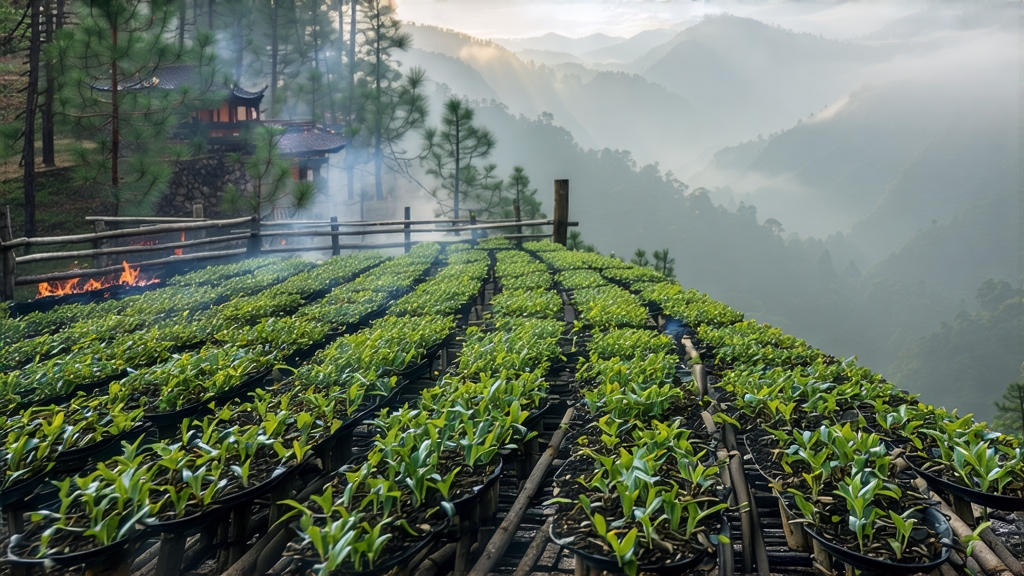
Ask most tea lovers to name a Chinese black tea and they will answer Keemun or Dian Hong; ask a historian which black tea came first and the reply is always Lapsang Souchong. Born in the cool, mineral-rich folds of the Wuyi range along Fujian’s border with Jiangxi, this smoky, wine-dark leaf is the progenitor of every red tea (hong cha) on earth. Its story begins in the late Ming dynasty, around 1604, when passing Qing soldiers commandeered a village tea factory near Tongmu Pass. To dry the leaves quickly before the troops returned, workers spread them over fresh pine fires; the resulting resin-laden liquor so delighted Dutch traders in Xiamen that they bought every basket and shipped it to Europe. Within decades “bohea” (the Fujianese pronunciation of “Wuyi”) became the generic English word for black tea, and Lapsang Souchong—literally “small sort from Lapu mountain”—was the toast of London coffee-houses long before Earl Grey was blended.
Geography is the first secret. Tongmu Guan sits at 27° N, 1,200 m above sea level, where mist rising from the Jiuqu (“Nine Bends”) River wraps the cliffs 200 days a year. The humid air slows photosynthesis, packing the slow-growing leaves with amino acids and volatile sugars that later marry with pine smoke. Only five villages inside a 60 km² core zone may legally sell authentic Zheng Shan (“Original Mountain”) Lapsang; step outside that invisible fence and the same cultivars yield a mere “smoked black,” lacking the subtle balance of ember, fruit, and mineral.
Cultivar matters next. The indigenous small-leaf Xiao Ye Zhong, a shrub first documented in 1168, dominates the area. Its narrow, waxy blades resist the high heat of withering baskets and absorb just enough resin to perfume, not overpower. In recent years clonal Wuyi Qizhong and Rougui have been trialed for a sweeter cup, yet purists still prefer the old seed-grown plants whose roots dive into weathered tuff and granite, mining iron, potassium, and rare earths that translate into a cooling, metallic finish on the tongue.
Crafting Lapsang is a dialogue between wood, leaf, and weather. Picking starts around Qingming when two leaves and a bud reach 3–4 cm. The sprouts are carried in bamboo trays lined with hemp cloth to prevent bruising; any premature oxidation would blunt the clarity of the final cup. Sun-withering lasts only 20–30 min on mats of woven palm, just enough to reduce moisture to 65%. The leaves then move upstairs to the louvers of the “qing lou” smoking room, where a gentle fire of 40-year-old Masson pine smoulders at 40–45 °C. Unlike the harsh flames used for commodity smoked teas, here the logs are first burned down to coals, then blanketed with fresh sawdust that releases a steady stream of cool, aromatic smoke. Over six hours the leaves lose another 20% moisture while inhaling guaiacol and syringol, the same phenols that give bacon its crave-worthy scent.
Rolling comes next, but softly: 30 min in a bamboo drum that turns 18 times per minute, just enough to rupture cell walls without breaking the tips. Oxidation is unusually short—45 to 60 min—because the smoke has already fixed many polyphenols. A second, hotter smoking at 80 °C for 15 min halts enzymatic activity and sets the chocolate-brown color. Finally the tea is charcoal-baked for three hours using embers from the same pine; this “pulls” excess resin to the surface so the cup is fragrant yet not tarry. The entire process, from pluck to finished leaf, takes less than 24 h, a sprint compared with the three-day choreography of Keemun.
The result is two distinct commercial styles. Traditional Song Zhong (“Pine-Smoke Classic”) carries a bold, campfire nose that fills a room the moment the tin is opened. Dry leaves are glossy, almost oily, and jet black with mahogany edges. Infused, they smell of longan, dried lychee, and the sweet resin of a just-snuffed beeswax candle. The liquor is a clear crimson, turning amber at the meniscus, with a silky body that coats the palate in layers: first honey, then cured meat, finally a cooling camphor note